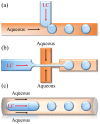Liquid Crystal Biosensors: Principles, Structure and Applications
- PMID: 36005035
- PMCID: PMC9406233
- DOI: 10.3390/bios12080639
Liquid Crystal Biosensors: Principles, Structure and Applications
Abstract
Liquid crystals (LCs) have been widely used as sensitive elements to construct LC biosensors based on the principle that specific bonding events between biomolecules can affect the orientation of LC molecules. On the basis of the sensing interface of LC molecules, LC biosensors can be classified into three types: LC-solid interface sensing platforms, LC-aqueous interface sensing platforms, and LC-droplet interface sensing platforms. In addition, as a signal amplification method, the combination of LCs and whispering gallery mode (WGM) optical microcavities can provide higher detection sensitivity due to the extremely high quality factor and the small mode volume of the WGM optical microcavity, which enhances the interaction between the light field and biotargets. In this review, we present an overview of the basic principles, the structure, and the applications of LC biosensors. We discuss the important properties of LC and the principle of LC biosensors. The different geometries of LCs in the biosensing systems as well as their applications in the biological detection are then described. The fabrication and the application of the LC-based WGM microcavity optofluidic sensor in the biological detection are also introduced. Finally, challenges and potential research opportunities in the development of LC-based biosensors are discussed.
Keywords: LC-based biosensors; liquid crystals; microfluidics; optofluidic; whispering gallery mode.
Conflict of interest statement
The authors declare no conflict of interest.
Figures










Similar articles
-
Applications of Microfluidics in Liquid Crystal-Based Biosensors.Biosensors (Basel). 2021 Oct 12;11(10):385. doi: 10.3390/bios11100385. Biosensors (Basel). 2021. PMID: 34677341 Free PMC article. Review.
-
Applications of liquid crystals in biosensing.Soft Matter. 2021 May 14;17(18):4675-4702. doi: 10.1039/d0sm02088e. Epub 2021 Apr 6. Soft Matter. 2021. PMID: 33978639
-
Liquid crystal-amplified optofluidic biosensor for ultra-highly sensitive and stable protein assay.Photonix. 2021;2(1):18. doi: 10.1186/s43074-021-00041-1. Epub 2021 Aug 28. Photonix. 2021. PMID: 34806024 Free PMC article.
-
Overview of Liquid Crystal Biosensors: From Basic Theory to Advanced Applications.Biosensors (Basel). 2022 Mar 29;12(4):205. doi: 10.3390/bios12040205. Biosensors (Basel). 2022. PMID: 35448265 Free PMC article. Review.
-
Quantitative and sensitive detection of lipase using a liquid crystal microfiber biosensor based on the whispering-gallery mode.Analyst. 2020 Nov 23;145(23):7595-7602. doi: 10.1039/d0an01187h. Analyst. 2020. PMID: 32975244
Cited by
-
Liquid Crystal Microcavity Biosensors for Real-Time Liver Injury Monitoring via Whispering Gallery Mode Laser.Research (Wash D C). 2025 Aug 5;8:0824. doi: 10.34133/research.0824. eCollection 2025. Research (Wash D C). 2025. PMID: 40765994 Free PMC article.
-
Optical biosensor based on weak measurement for ultra-sensitive detection of calreticulin in human serum.Biomed Opt Express. 2024 Jan 16;15(2):715-724. doi: 10.1364/BOE.514443. eCollection 2024 Feb 1. Biomed Opt Express. 2024. PMID: 38404297 Free PMC article.
-
Liquid crystal-assisted optical biosensor for early-stage diagnosis of mammary glands using HER-2.Sci Rep. 2023 Apr 26;13(1):6847. doi: 10.1038/s41598-023-31668-8. Sci Rep. 2023. PMID: 37100835 Free PMC article.
-
Computational Analysis on the Performance of Elongated Liquid Crystal Biosensors.Micromachines (Basel). 2023 Sep 26;14(10):1831. doi: 10.3390/mi14101831. Micromachines (Basel). 2023. PMID: 37893268 Free PMC article.
References
-
- Prévôt M.E., Nemati A., Cull T.R., Hegmann E., Hegmann T. A zero-power optical, ppt-to ppm-level toxic gas and vapor sensor with image, text, and analytical capabilities. Adv. Mater. Technol. 2020;5:2000058. doi: 10.1002/admt.202000058. - DOI
-
- Tefelska M.M., Woliński T.R., Ertman S., Mileńko K., ączkowski R., Siarkowska A., Domański A.W. Electric field sensing with photonic liquid crystal fibers based on micro-electrodes systems. J. Light. Technol. 2015;33:2405–2411. doi: 10.1109/JLT.2014.2379691. - DOI
Publication types
MeSH terms
Grants and funding
LinkOut - more resources
Full Text Sources

